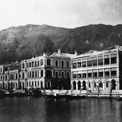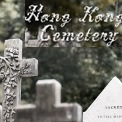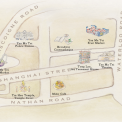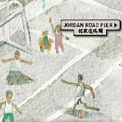Ho Chi Minh in Victoria Gaol by Samson Chan (2011)
The national father of the Socialist Republic of Vietnam and the great master of the Vietnamese revolution, President Ho Chi Minh, was detained at Victoria Gaol in 1931. There were a number of interesting rumours surrounding Ho’s imprisonment in Hong Kong including the story on his death inside the prison as a result of illness, his escape from prison and his agreeing to spy for the British in exchange for his secret release by the Hong Kong Government on 22 January 1933.
Nguyen Ai Quoc or Nguyen Tat Thanh, the names used by Ho in the 1920s, was in southern China setting up the Vietnamese Revolutionary Youth Association and organized “Communist League” as the core of the association, training communist cadres to lead the association and popularize Marxism-Leninism in Vietnam. He was sentenced to death (in absentia) on 10 October 1929 from the Vinh Court in Indochina for his involvement in the revolutionary work and he was wanted by the French authority.
Nguyen came to Hong Kong and his hideout was detected by the French and the information was passed to the Hong Kong authority for his arrest and extradition back to Indochina. Nguyen was subsequently arrested by the Hong Kong police on 6 June 1931 at his Kowloon residence. He refused to admit his true identity as Nguyen Ai Quoc and insisted in claiming himself to be Sung Man Cho, a Chinese national. As there were insufficient grounds for his extradition to Indochina, Nguyen was put inside Victoria Gaol on 12 June 1931 until 12 August 1931 when he was handed over to the Inspector General of Police for intended deportation to Indochina on board a French ship. This action, if carried out as planned, would mean certain death for Nguyen.
With the successful application of habeas corpus by his lawyer Francis Loseby, Nguyen was able to delay his deportation and appeared in court for a number of times to challenge the legality of his arrest and the detention as well as the subsequent interrogation by the officials from the Secretary of Chinese Affairs. Throughout the period of the court proceedings, he was under the custody of the Inspector General of Police.
When appeared in the Supreme Court for the eighth times on his legal case Sung Man Cho v. The Superintendent of Prisons on 11 September 1931, the Court ruled that the deportation order should stand and Nguyen to be deported to Indochina. His lawyer immediately stated that he would lodge an appeal to the Privy Council in London. The appeal application was approved and the lawyer was given three months to submit the appeal documents. As Nguyen was suffering from dysentery and tuberculosis, he was transferred to stay in the prison hospital since November 1931.
In June 1932, Nguyen’s lawyer in London and the lawyers for the British Colonial Office settled the appeal case out of court with the Privy Council endorsing the decision on 21 July 1932. The settlement reached was that the Deportation and Ship order issued by the Hong Kong Government to stand but Nguyen would not be put on any French ship or deported to Indochina or any French territories and he could choose anywhere he likes to go with the assistance of the Hong Kong Government, plus paying cost of £250 for Nguyen. To throw off the French interest on Nguyen upon his impending release from custody, his lawyer started a disinformation scheme in Hong Kong by spreading rumour on Nguyen’s death in prison because of illness and this news were carried not only by the local newspaper but also international press.
Nguyen was secretly released from the prison hospital and police detention on 28 December 1932. As arranged, a Cadet Officer attached to the Secretariat for Chinese Affairs took Nguyen out from the prison hospital in a car and released him in the streets. Before he boarded a ship to Singapore on 12 January 1933, he was arranged by his lawyer to stay at the Chinese YMCA by pretending to be a visiting scholar. Nguyen was however refused entry in Singapore and had to return to Hong Kong and was arrested by the Hong Kong police upon his arrival on 19 January. Governor of Hong Kong Sir William Peel eventually arranged Nguyen, together with a Chinese staff of Loseby’s law firm, to be conveyed in a non-Government launch which took them out of the harbour to board the ship “Anhui” as belated passengers heading for Amoy. They departed Hong Kong on 22 January 1933.
Ho Chi Minh did mention briefly his life whilst under detention in Victoria Gaol.
“The Hong Kong detention centre was huge and called Victoria Gaol…The building where they held Uncle had three storeys, with two rows of cells on each floor. The construction of the cells was such that they weren’t even worth measuring! Each cell was three yards high but only one yard wide and less than two yards long – with only enough space for a person to lie kitty-corner. High above one’s head was a small half-moon window covered with a grid of iron bars. By day, the light leaking from the window seemed timid and out of its element in the cell. The door to the cell was made from planks as thick as the spread of one’s hand and encased in steel. A peephole at eye level was shaped like a megaphone with the wide end on the inside and the narrow end, outside.
From time to time, the guards (who were Indians, Sikhs, and British) pressed an eye to the peephole to check on the prisoner in the cell.
Every day, the prisoners were allowed outside their cells for fifteen minutes to stroll around a narrow courtyard. The tight yard’s four sides were towering prison buildings with gloomy walls, making one feel he was pacing in the bottom of a well. By lifting his head, one could see a patch of sky only as large as a handkerchief. It was stifling inside his cell, but once outside, it was also still stifling.
Each day, the prisoners had two meals of cooked rice mixed with unhusked rice. One-quarter of the mixture was unhusked. One day the ration would include water spinach in the morning and rotten pickled fish sauce or rancid fish in the afternoon. The next day, they would change to “suit each guest’s taste” and served rotten pickled fish sauce or rancid fish in the morning and water spinach in the afternoon. Each week, the prisoners received one special meal: a serving of cooked white rice and a few bites of beef.”
Excerpt from the section in Vu'a di du'ong vu'a ke chuyen (Stories Told on the Trail) describing President Ho Chi Minh’s legal case in Hong Kong. President Ho wrote Vu'a di du'ong vu'a ke chuyen (Stories Told on the Trail) in 1961 under the pseudonym, T. Lan.
References:
Books:
Borton, L. (2007) Ho Chi Minh – A Journey, Vietnam: Gioi.
Duiker, W. (2000) Ho Chi Minh, New York: Hyperion.
Duncanson, D. (1974) ‘Ho-chi-Minh in Hong Kong, 1931-32’, China Quarterly, No. 57, pp. 84-100.
Fenn, C. (1973) Ho Chi Minh: A Biographical Introduction, New York: Seribner.
The Ho Chi Minh Museum, (2006) The Legal Case of Nguyen Ai Quoc (Ho Chi Minh) in Hong Kong 1931-1933, Vietnam: The National Political Publishers.
Huyen, N. (1971) Vision Accomplished? The Enigma of Ho Chi Minh, New York: Collier Books.
Lacouture, J. (1967) Ho Chi Minh: Political Leaders of the Twentieth Century, Middlesex: Penguin Books.
Quinn-Judge, S. (2003) Ho Chi Minh: the Missing Years 1919-1941, London: Hurst & Company.
Sainteny, J. (1972) Ho Chi Minh and His Vietnam: A Personal Memoir, Chicago: Cowles Book Company.
Warbey, W. (1972) Ho Chi Minh and the Struggle for an Independent Vietnam, London: Merlin Press.
Official Record (Colonial Office):
CO129/539/2
Newspaper:
South China Morning Post, 8 August 1932.





